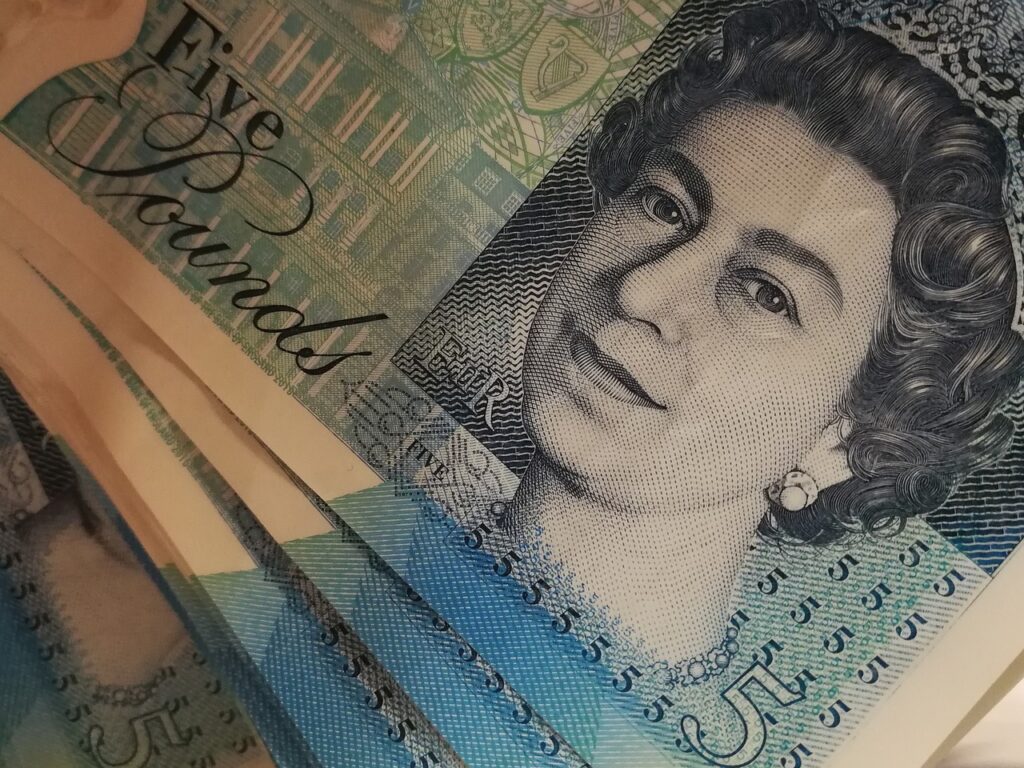The pound the oldest existing currency in the world
The pound, or Pound Sterling as its formal name is, is the oldest existing currency with origins that can be traced back to continental Europe. The UK is the sixth largest economy in the world and the second largest in Europe after Germany. As far as history shows us, they are a force to be reckoned with. After all, it is the UK that started the industrial revolution.
The name of this currency comes from the Latin word ‘libra’, which refers to weight and balance. For more than 300 years, the Bank of England has been the authority that issues pound banknotes, and throughout this time these banknotes have undergone many changes.
The first pound coin did not appear until 1489, during the reign of Henry VII. Pound notes began to circulate in England shortly after the establishment of the Bank of England in 1694 and were originally handwritten notes. The pound operated with its complicated system of shillings and pennies until the arrival of the decimal system in 1971.
In 1660, the coinage was mechanized and features in its design such as side letters were introduced to help eradicate money clipping.
The pound has survived as an independent currency while most of the rest of Europe adopted the euro as a common currency, which in the early 2000s also seemed the likely fate of the pound.
As for the ‘pound sterling’, it existed until the Act of Union of 1707 created a new monetary system based on the value of the pound south of the Scottish border. The Bank of Scotland was created in 1695, just one year after the Bank of England, and it still survives today as part of HBOS, a subsidiary of Lloyds Banking Group, based in Edinburgh.
Countries using the pound sterling
The pound sterling is the official currency of the United Kingdom (comprising England, Scotland, Wales and Northern Ireland).
The pound in the foreign exchange market
In the currency market, the GBP/USD pair is also known as the cable.
The best times to trade British pounds (GBP)
Financial news events provide two main benefits for trading the British pound. The first is an obvious trend, while the second is higher liquidity. Economic news can come at unpredictable times, but much of it is regularly released by financial institutions and governments.
Currency pairs and trading hours
The British pound (GBP) is the fourth most traded currency in the world, behind the US dollar (USD), the euro (EUR) and the Japanese yen (JPY). GBP also ranks third in global reserves. GBP traders speculate on strength and weakness through currency pairs that establish comparative value in real time. Although forex brokers offer dozens of related crosses, most clients focus on the four most popular pairs:
– US dollar: GBP / USD
– Swiss franc: GBP / CHF
– Japanese Yen: GBP / JPY
– Euro: EUR / GBP
GBP trades continuously from Sunday evening to Friday afternoon in the US and offers significant profit opportunities. However, volume and volatility vary widely in each 24-hour cycle, with spreads widening in slow periods and narrowing during active periods. While the ability to open and close positions at any time marks a currency advantage, most trading strategies work best during tough periods.
British pound catalysts
The best times to trade this instrument track the publication of critical economic data as well as the opening hours of stock, options and futures exchanges. Planning for these releases requires double-sided research as local (UK) economic news can move popular GBP pairs with the same intensity as news in other locations.
Moreover, the pairs are highly susceptible to economic and political macro events that trigger highly correlated price action across stocks, currencies and bond markets around the world. China’s devaluation of the yuan in August 2015 provides a perfect illustration. Even natural disasters have the power to generate this kind of coordinated response, as evidenced by the 2011 Japanese tsunami. The coronavirus bear market in stocks also led to dramatic swings in currency values as carry trade collapsed.
There are also major economic events, such as Black Wednesday and Brexit, that affect the direction of the British pound for several years. Currency traders can make a huge amount of money by betting in the right direction. However, it is crucial to get out of the wrong side of these deals quickly.
Economic news
The majority of the monthly economic data from the UK comes out in the early morning European time. Thirty to 60 minutes before these releases and one to three hours afterward highlight the best times to trade GBP as the news flow will affect the value of the pound. The majority of European data becomes available around the same time as UK data. That makes it an excellent time to trade European currency pairs.
US economic releases usually occur between 8:30 and 10:00 am Eastern time and also generate extraordinary GBP trading volume. There are good odds of strong trending price action in several or all pairs. Japanese emissions receive less attention because they occur when the UK is in the middle of its sleep cycle.
British pound and stock time change
Many GBP traders’ schedules roughly follow exchange times, with most of their activity occurring when stocks in Frankfurt and New York are open for business. This localization generates a spike in trading volume around midnight on the U.S. East Coast, continuing throughout the night and into the U.S. lunch hour when currency trading can drop sharply.
However, central bank agendas are shifting this cycle of activity with currency traders across the world staying at their desks when the Federal Reserve (FOMC) is scheduled to release the 2pm interest rate decision or the minutes of the previous meeting. The Bank of England (BOE) makes its interest rate decisions at 7 am, and the European Central Bank (ECB) follows at 7 pm. 07.45, leading to a high level of activity.
Four popular currency pairs offer British pound traders a variety of short- and long-term opportunities. The best times to trade these instruments are centered around key economic releases when European and US stock exchanges keep all cross markets active and highly liquid.
Five reports affecting the British pound
Due to its popularity and familiarity among traders, many people who start trading forex often choose GBP as one of the currencies they trade. For traders dealing with fundamentals (economic reports and news events), they can save a lot of time knowing which reports to follow that affect GBP the most and provide guidance on specific areas to focus their efforts on. That said, this article will find some economic reports that should be useful for newer traders as a starting point for further research.
Five core areas
Before we start, it is important to understand that all currencies in different countries are generally affected by the same underlying economic factors. Specifically, five factors that tend to affect all currencies the most include monetary policy, price inflation, confidence and sentiment, economic growth (GDP) and the balance of payments. Using these five general factors as a template, you can then determine which reports are most important in forming a comprehensive picture of the direction of a currency.
Prices and inflation
Reports to focus on CPI, PPI.
The first important factor, price and inflation, plays a crucial role in the value of the GBP. In general, countries with high levels of inflation relative to other countries see their currency depreciate more compared to the other currencies. Moreover, inflation usually also prompts the central bank to take action, such as adjusting interest rates to control these undesirable effects.
To measure inflation levels in the UK, traders will usually follow the Consumer Price Index (CPI), compiled and released by the Office for National Statistics. The CPI calculates the change in prices of goods and services purchased by consumers over a given period. This report is important because it is the measure the Bank of England (BOE) uses for its inflation target. Any changes in the CPI that deviate from the BOE’s inflation target could imply future monetary policy measures that could significantly affect the GBP.
Moreover, although consumer prices tend to influence most changes in the level of inflation, other measures such as the producer price index (PPI) are also useful. The PPI is considered by many to be a leading indicator of inflation as it shows changes in inflation at the commodity level that can eventually work their way up to the consumer level, as reflected in the CPI. The PPI report was also released earlier than the CPI, so both should be viewed together for a more complete picture.
Monetary policy
The monetary policy adopted by the Bank of England (BOE) is also an important factor to consider. One of the BOE’s core mandates is to promote monetary stability defined by the bank as “low inflation and confidence in the currency.” Whenever the BOE feels that inflation reaches a level that threatens the stability of the pound, it will use monetary policy tools to control inflation. It is the timing of this monetary policy, such as interest rate changes that traders want to predict.
To keep track of monetary policy, traders will follow changes in the bank rate, which is the interest rate that banks charge other banks on balances held at the BOE. Interest rate decisions are determined by the Monetary Policy Committee (MPC) each month and are available on the Bank of England website. Note that if the MPC simply maintains the previous bank rate, there will generally be no accompanying discussion. However, if there is a change in speed, the MPC will release a statement that is more interesting and may give clues about future actions.
Trust and feeling
Reports to focus on: Gfk Consumer Confidence, Nationwide Consumer Confidence
Surveys that measure market sentiment are another important tool for fundamental traders. Confidence and sentiment reports for the UK are important because traders want to know if the majority of people are optimistic about the economy or pessimistic. The changes and the size of the change can be key to detecting shifting trends in the underlying economy and thus changes in GBP.
To track sentiment in the UK, many traders will follow the Gfk Consumer Confidence, and Nationwide Consumer Confidence Index (NCCI) reports. Both reports are surveys based on five questions concerning the general economic environment, employment and future expectations. The main difference between the reports is the time periods used. For NCCI, the survey reflects the respondent’s feelings towards their current situation and their expectations for the next six months. On the other hand, the Gfk reflects respondents’ feelings towards events that happened in the last 12 months and their expectations for the next 12 months. Both can be used to measure sentiment towards the direction of the UK economy.
GDP/economic growth
Reports to focus on: manufacturing PMI, services PMI, retail sales, GDP
The overall level of the UK economy is another key factor that can affect currency values. The primary measure of economic activity in the UK, as in many other countries, is gross domestic product (GDP). There are three different GDP reports that traders should be aware of – preliminary GDP, revised GDP and final GDP. The preliminary GDP estimate is released earliest and tends to have the greatest impact as it gives traders a first look at the UK’s economic health. Prelim GDP is also the least accurate and tends to be revised in the follow-up Revised GDP and Final GDP reports.
As GDP is a quarterly report, many traders will also supplement it with more frequent indicators of economic activity such as the retail sales, manufacturing PMI and services PMI. As consumers are generally regarded by many as drivers of economic activity, the retail sector is usually given a greater weighting.
Balance of payments
Reports to focus on: trade balance, current account balance
Finally, the balance of payments (BoP) of a country is a record of its interaction with the rest of the world. The BoP consists of three accounts, but generally only the current account is of interest to currency traders. The current account shows how much a country exports and imports and the flow of income and transfer payments. In general, a current account surplus is positive for the currency because it shows that more capital is flowing into the currency than leaving, and a deficit is negative for the opposite reason.
It should also be noted that the trade balance report is released monthly, while the current account is released quarterly. If you are only looking for import/export data, the trade balance would be the report to use.
Summary
There are many economic indicators that can affect the pound. Knowing which data reports to use is the first step. Being able to interpret and combine reports to generate a trade direction is the hardest part. But if you are starting out and want to base your pound-based business on fundamental reports, these five key areas are a good place for you to start.
About the Viking
With Viking’s signals, you have a good chance of finding the winners and selling in time. There are many securities. With Viking’s autopilots or tables, you can sort out the most interesting ETFs, stocks, options, warrants, funds, and so on.
Click here to see what Vikingen offers: Detailed comparison – Stock market program for those who want to become even richer (vikingen.se)













